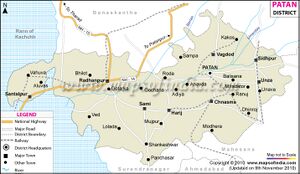Patan Gujarat
Note - Please click → Patan for details of similarly named villages at other places.

Patan (पाटन)/(पाटण) is a town and District in Gujarat. It was capital of Gujarat in medieval times.
Variants of name
It is variously referred to in Sanskrit literature as
- Anahilapataka(अणहिलपाटक) - Towns and Villages of Chauhan Dominions- SN:170. mentioned in Nanana grant of Alhana S.V.1219 & S.V.1220. Identified by Dasharatha Sharma as Modern Patan Gujarat (पाटण) 25N. 70E. in Gujarat
- Anahillapura (Anahilapataka) (Verse-11: Sunda hill Inscription of Chachigadeva)
- Anahipattan,
- Anahilpur,
- Anahilvad Pattan,
- Analwara,
- Anhilpur Patan,
- Anhilwad Patan,
- Naharwala,
- Pattan .
- Anhalavada (अन्हलवाड़ा) (गुजरात)= Patan (पाटन) (AS, p.24)
- Anhilavada (अन्हिलवाड़) (AS, p.24)
Location
पाटन या पाटण अब भी एक छोटा-सा क़स्बा है जो महसाणा से 25 मील दूर है।
History
The city has many Hindu and Jain temples and a few mosques, dargahs and rojas. The city has many historical places also. Patan, an ancient fortified town, was founded in 745 AD by Vanraj Chavda, the most prominent king of the Chavda Kingdom. He named the city Anhilpur Patan or "Anhilwad Patan" after his close friend and Prime Minister Anhila.
The Chalukyas, with Paramaras of Malwa, the Chauhans of Sakambhari and Chandelas of Kalinjar and Mahoba, were serious contestants for supremacy in northern India. At the zenith of their imperial greatness the bounds of Gujarat were extended to cover Saurashtra and Kutch in the West, Lata in the South, Malwa in the East and Southern Rajasthan in the North. Historian Tertius Chandler estimates that Anhilwara was the tenth-largest city in the world in the year 1000, with a population of approximately 100,000.
When Muizzuddin Muhammad Ghori had attempted to conquer Gujarat, the forces of Mularaja-II, the then King of Patan, a mere boy-ruler, led by his heroic mother Naikidevi, inflicted such a crushing and conclusive defeat on him that the foreigner did not dare again during his lifetime to cast his greedy eye upon Patan. He never again entered India through Gujarat. The battle was fought at Kayadra, a village near Mount Abu. Muizzuddin’s army was completely routed in the conflict, but somehow he escaped with his defeated army from Gujarat. Muhammed's general (and later Sultanate of Delhi Qutb-ud-din Aybak sacked the city between 1200 and 1210, and it was destroyed by the Alladin Khilji in 1298.
James Tod[1] writes that The Balhara kings, and their capital Nahrwala, or Anhilwara Patan, have given rise to much conjecture amongst the learned. We shall, endeavour to condense what has been said by ancient and modern authorities on the subject ; and from manuscripts, ancient inscriptions, and the result of a personal visit to this ancient domain, to set the matter completely at rest. [2] Baleo Kouros has been identified with Vilivāyakura, a name found on coins of the Andhra dynasty. [3]
James Tod[4] writes that at all events, the prince of Deo laid the foundation of Anhilwara Patan in S. 802 (A.D. 746), which henceforth became the capital city of this portion of India, in lieu of Valabhipura, which gave the title of Balakaraes to its princes, the Balhara of the earlier Arabian travellers, and following them, the geographers of Europe. The Balhara of Arab travellers of the tenth century were the Rashtrakuta dynasty of Malkhed, Balhara being a corruption of Vallabha-raja, Vallabha being the royal title. [5]
Jat History
See - Warahi Jatwad
Char or Chawara
H. W. Bellew[6] writes that The next tribe of the Sharkhbun branch of the Sarbani Afghan is the Shirani, called also Char (Chawara or Chaora Rajput). The Chaora, according to Colonel Tod (Annals of Rajasthan), was once a renowned tribe in the history of India, though its name, he says, is now scarcely known, and its origin is veiled in obscurity. It belongs neither to the Solar race nor the Lunar race, and is probably of Skythic descent. The name is unknown in Hindustan, and is confined, with many others originating beyond the Indus, to the peninsula of Saurashtra. If foreign to India proper, continues Tod, its establishment must have been at a remote period, as individuals of the tribe intermarried with the Surajbansi ancestry of the present princes of Mewar, when this family were the lords of Balabhi. The capital of the Chaora was the insular Deobandar, on the coast of Saurashtra, and the temple of Somnath, with many others on this coast, dedicated to Balnath, is attributed to this tribe of the Saura or worshippers of the sun. It was Vena Raja or Banraj, prince of Deo, who, 746, A.D., laid the foundation of Anhalwara, which his dynasty ruled for one hundred and eighty-four years, when Bhojraj, the seventh from the founder and the last of the Chaora, was deposed, 931 A.D., by his own daughter's son, Mulraj of the Solanki tribe. Mulraj ruled Anhalwara for fifty-eight years. During the reign of his son and successor, Chawand or Chaond Rae, called Jamand by Muhammadan historians, Mahmud of Ghazni invaded the kingdom of Anhalwara, and drained it of its immense riches, for Anhalwara was at that time the entrepot of the productions of the eastern and the western hemispheres.
पंचसर
विजयेन्द्र कुमार माथुर[7] ने लेख किया है ...पंचसर (AS, p.515) महसना ज़िला, गुजरात में कच्छ के रन के निकट स्थित एक प्राचीन नगर है। चावड़ा वंश के वनराज ने इस नगर को सरस्वती नदी के तट पर स्थित प्राचीन ग्राम 'लखराम' की जगह बसाया था। यह सूचना जैन धर्म की पट्टावलियों से मिलती है। 10वीं शती में चावड़ा वंश के नरेश जयकृष्ण की राजधानी पंचसर में स्थित थी। जयकृष्ण के पुत्र वनराज ने पंचसर को छोड़कर पाटन में अपनी राजधानी बनाई स्थापित कर ली थी। हाल ही में पूर्व सोलंकी वंश के काल एक मंदिर के अवशेष यहाँ से उत्खनन में प्रकाश में लाए गए हैं। प्रतीत होता है कि इस मंदिर का निर्माण दशवी शती में किया गया था। (दे. अनहलवाड़ा)
लखराम
विजयेन्द्र कुमार माथुर[8] ने लेख किया है ...लखराम (AS, p.811) गुजरात स्थित एक ऐतिहासिक स्थान था। गुजरात के प्रसिद्ध नगर 'पाटन' या 'अन्हिलवाड़ा' की स्थापना 746 ई. में इसी ग्राम के स्थान पर वनराज चावड़ा द्वारा की गई थी। यह ग्राम सरस्वती नदी के तट पर बसा हुआ था. (दे. अनहलवाड़ा)
अन्हलवाड़ा
विजयेन्द्र कुमार माथुर[9] ने लेख किया है ...अन्हलवाड़ा (गुजरात)= पाटन (AS, p.24): अन्हिलवाड़ अथवा अन्हलवाड़ा प्राचीन गुजरात की महिमामयी राजधानी थी जिसकी स्थापना चावड़ा वंश के वनराज या बंदाज द्वारा 746 ई. में हुईं थी। उसे इस कार्य में जैनाचार्य शीलगुण से विशेष सहायता मिली थी। इसको गुजरात का पाटन नगर भी कहा जाता है।
चावड़ा वंश के वनराज के पिता जयकृष्ण का राज्य, कच्छ की रण के निकटस्थ पंचसर नामक स्थान पर था। वनराज ने नए नगर को सरस्वती नदी के तट पर स्थित प्राचीन ग्राम लखराम की जगह बसाया था। यह सूचना हमें जैन पट्टावलियों से मिलती है। धर्मसागर कृत प्रवचन परीक्षा में 1304 ई. तक अन्हलवाड़ा के राजाओं का वर्णन है। एक किंवदंती के अनुसार जब 770 ई. के लगभग अरब आक्रमणकारियों ने काठियावाड़ के प्रसिद्ध नगर वल्लभीपुर को नष्ट कर दिया तो वहां के राजपूतों ने अन्हलवाड़ा बसाया था।
अन्हलवाड़ा में चावड़ा वंश का शासनकाल 942 ई. तक रहा। इस वर्ष चालुक्य अथवा सोलंकी वंश के नरेश मूलराज ने गुजरात के इस भाग पर अधिकार कर लिया। चालुक्य-शासनकाल में गुजरात उन्नति के शिखर पर पहुंच गया। मूलराज ने सिद्धपुर में रुद्रमहालय नामक देवालय निर्मित किया था। इस वंश में सिद्धराज जयसिंह (1094-1143 ई.) सबसे प्रसिद्ध राजा था। यह गुजरात की प्राचीन लोक-कथाओं में मालवा के भोज की तरह ही प्रसिद्ध है। जैनाचार्य हेमचंद्र, सिद्धराज के ही राज्याश्रय में रहते थे। हेमचंद्र और उनके समकालीन सोमेश्वर के ग्रन्थों में 12वीं शती के पाटन के महान् ऐश्वर्य का विवरण मिलता है।
सिद्धराज के समय में इस नगर में अनेक सत्रालय और मठ स्थापित किए गए थे। इनमें विद्वानों और निर्धनों को नि:शुल्क भोजन तथा निवासस्थान दिया जाता था। इस काल में पाटन, गुजरात की राजनीति, धर्म तथा संस्कृति का एकमात्र महान् केन्द्र था। जैन धर्म की भी यहां 12वीं शती में बहुत उन्नति हुई। सिद्धराज विद्या तथा कलाओं का प्रेमी था और विद्वानों का आश्रयदाता था।
सिद्धराज के पश्चात् मुसलमान आक्रमणकारियों ने इस नगर की सारी [p.25}: श्री समाप्त कर दी। गुजरात में किंवदंती है कि महमूद गजनवी ने इस नगर को लूटा ही था किंतु मुहम्मद तुग़लक़ ने इसे पूरी तरह उजाड़ कर हल चलवा दिए थे। मुहम्मद तुग़लक़ से पहले अलाउद्दीन खिलजी ने 1304 ई. में पाटन नरेश कर्ण बघेला को परास्त किया था और इस प्रकार यहाँ के प्राचीन हिंदू राज्य की इतिश्री कर दी थी। 15वीं शती में गुजरात का सुलतान अहमदशाह पाटन से अपनी राजधानी उठा कर नए बसाए हुए नगर अहमदाबाद में ले गया और इसके साथ ही पाटन के गौरव का सूर्य अस्त हो गया।
पाटन या पाटण अब भी एक छोटा-सा क़स्बा है जो महसाणा से 25 मील दूर है। स्थानीय जनश्रुति है कि महाभारत में उल्लिखित हिडिंब वन पाटन के निकट ही स्थित था और भीम ने हिडिंब राक्षस को मारकर उसकी बहिन हिडिंबा से यहीं विवाह किया था। पाटन के खण्डहर सहस्त्रलिंग झील के किनारे स्थित हैं। इसकी खुदाई में अनेक बहुमूल्य स्मारक मिले हैं- इनमें मुख्य हैं भीमदेव प्रथम की रानी उदयमती की बाव या बावड़ी, रानी महल और पार्श्वनाथ का मंदिर। ये सभी स्मारक वास्तुकला के सुंदर उदाहरण हैं।
Jat history
Population
Notable persons
- Shankar Chaudhary - MLA Radhanpur in Patan Gujarat and General Secretary Youth BJP, Mob:09825313199
References
- ↑ James Tod: Annals and Antiquities of Rajasthan, Volume I, Annals of Mewar,p.250, fn-1
- ↑ " Hippokoura, the royal seat of Baleo Kouros " (Periplus, viii. 83).
- ↑ BG, i. Part ii. 158 ; McCrindle, Ptolemy, 179.
- ↑ James Tod: Annals and Antiquities of Rajasthan, Volume I, Chapter 7 Catalogue of the Thirty Six Royal Races,p.122
- ↑ BG, i. Part ii. 209.
- ↑ An Inquiry Into the Ethnography of Afghanistan By H. W. Bellew, The Oriental University Institute, Woking, 1891, p.165
- ↑ Aitihasik Sthanavali by Vijayendra Kumar Mathur, p.515
- ↑ Aitihasik Sthanavali by Vijayendra Kumar Mathur, p.811
- ↑ Aitihasik Sthanavali by Vijayendra Kumar Mathur, p.24-25
Back to Jat Villages


